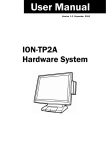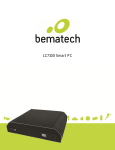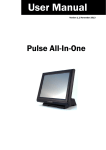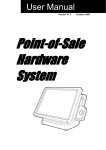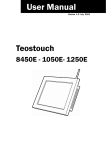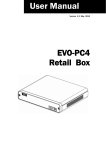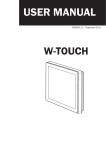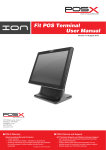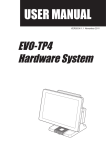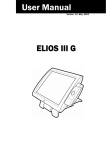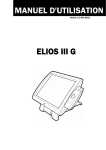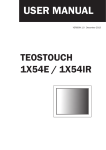Download User Manual
Transcript
User Manual Version 1.2 January 2013 Point-of-Sale Hardware System Copyright 2013 All Rights Reserved Manual Version 1.2 Part Number: 3LMPP3450412 The information contained in this document is subject to change without notice. We make no warranty of any kind with regard to this material, including, but not limited to, the implied warranties of merchantability and fitness for a particular purpose. We shall not be liable for errors contained herein or for incidental or consequential damages in connection with the furnishing, performance, or use of this material. This document contains proprietary information that is protected by copyright. All rights are reserved. No part of this document may be photocopied, reproduced or translated to another language without the prior written consent of the manufacturer. TRADEMARK Intel®, Pentium® and MMX are registered trademarks of Intel® Corporation. Microsoft® and Windows® are registered trademarks of Microsoft Corporation. Other trademarks mentioned herein are the property of their respective owners. i Safety IMPORTANT SAFETY INSTRUCTIONS 1. 2. 3. 4. 5. 6. 7. 8. 9. To disconnect the machine from the electrical Power Supply, turn off the power switch and remove the power cord plug from the wall socket. The wall socket must be easily accessible and in close proximity to the machine. Read these instructions carefully. Save these instructions for future reference. Follow all warnings and instructions marked on the product. Do not use this product near water. Do not place this product on an unstable cart, stand, or table. The product may fall, causing serious damage to the product. Slots and openings in the cabinet and the back or bottom are provided for ventilation; to ensure reliable operation of the product and to protect it from overheating. These openings must not be blocked or covered. The openings should never be blocked by placing the product on a bed, sofa, rug, or other similar surface. This product should never be placed near or over a radiator or heat register, or in a built-in installation unless proper ventilation is provided. This product should be operated from the type of power indicated on the marking label. If you are not sure of the type of power available, consult your dealer or local power company. Do not allow anything to rest on the power cord. Do not locate this product where persons will walk on the cord. Never push objects of any kind into this product through cabinet slots as they may touch dangerous voltage points or short out parts that could result in a fire or electric shock. Never spill liquid of any kind on the product. CE MARK This device complies with the requirements of the EEC directive 2004/108/EC with regard to “Electromagnetic compatibility” and 2006/95/EC “Low Voltage Directive” FCC This device complies with part 15 of the FCC rules. Operation is subject to the following two conditions: (1) This device may not cause harmful interference. (2) This device must accept any interference received, including interference that may cause undesired operation ii CAUTION ON LITHIUM BATTERIES There is a danger of explosion if the battery is replaced incorrectly. Replace only with the same or equivalent type recommended by the manufacturer. Discard used batteries according to the manufacturer’s instructions. Battery Caution Risk of explosion if battery is replaced by an incorrectly type. Dispose of used battery according to the local disposal instructions. Safety Caution Note: To comply with IEC60950-1 Clause 2.5 (limited power sources, L.P.S) related legislation, peripherals shall be 4.7.3.2 "Materials for fire enclosure" compliant. 4.7.3.2 Materials for fire enclosures For MOVABLE EQUIPMENT having a total mass not exceeding 18kg.the material of a FIRE ENCLOSURE, in the thinnest significant wall thickness used, shall be of V-1 CLASS MATERIAL or shall pass the test of Clause A.2. For MOVABLE EQUIPMENT having a total mass exceeding 18kg and for all STATIONARY EQUIPMENT, the material of a FIRE ENCLOSURE, in the thinnest significant wall thickness used, shall be of 5VB CLASS MATERIAL or shall pass the test of Clause A.1 LEGISLATION AND WEEE SYMBOL 2012/19/EU Waste Electrical and Electronic Equipment Directive on the treatment, collection, recycling and disposal of electric and electronic devices and their components. The crossed dustbin symbol on the device means that it should not be disposed of with other household wastes at the end of its working life. Instead, the device iii should be taken to the waste collection centers for activation of the treatment, collection, recycling and disposal procedure. To prevent possible harm to the environment or human health from uncontrolled waste disposal, please separate this from other types of wastes and recycle it responsibly to promote the sustainable reuse of material resources. Household users should contact either the retailer where they purchased this product, or their local government office, for details of where and how they can take this item for environmentally safe recycling. Business users should contact their supplier and check the terms and conditions of the purchase contract. This product should not be mixed with other commercial wastes for disposal. iv Revision History Revision Date V1.0 October, 2009 Release V1.1 May, 2011 C46 MB added C56 MB added C36 MB and C46 MB removed VFD installation changed 2nd installation changed V1.2 v January,2013 Description This page is intentionally left blank vi Table of Contents 1 Package Checklist.........................................1 1-1 1-2 Standard items .................................................................. 1 Optional items ................................................................... 2 2 System View ...................................................3 2-1 2-2 2-3 Front View .......................................................................... 3 Side View & Bottom View .................................................. 4 I/O View.............................................................................. 5 3 System Assembly & Disassembly.................6 3-1 3-2 3-3 Replace the HDD ............................................................... 6 Replace the Motherboard ................................................. 7 Stand Disassembly............................................................ 8 4 Peripheral Installation................................9 4-1 4-2 4-3 4-4 4-5 4-6 MSR installation ................................................................ 9 2-in-1 MSR + iButton Installation...................................10 2-in-1 MSR + Fingerprint Installation.............................11 Cash Drawer Installation.................................................12 VFD Installation ...............................................................14 2nd Display Installation....................................................16 5 Specification ............................................... 18 6 Jumper Settings .......................................... 20 6-1 6-2 6-3 C56 Motherboard Layout ................................................20 Connectors & Functions..................................................21 Jumper Settings...............................................................22 7 Appendix...................................................... 26 i 1 Package Checklist 1-1 Standard items a. System c. Power cord b. Power adapter d. RJ45 to DB9 cable (x2) e. Driver CD 1 1-2 Optional items a. MSR c. 2-in-1 MSR + Fingerprint e. VFD module 2 b. 2-in-1 MSR + iButton d. 2nd display module 2 System View 2-1 Front View 2 1 3 4 5 6 No. Description 1 Touch screen 2 MSR/2-in-1 MSR (optional) 3 HDD door 4 Stand 5 Ventilation 6 Power button 3 2-2 Side View & Bottom View 8 7 4 No. Description 7 Hinge cover 8 System box (motherboard inside) 2-3 I/O View No. Description a Cash drawer port b USB (x4) c LAN (10/100/1000) d COM1, 2, 3, 4 (from left to right) e 2nd VGA f DC In 19V g Power button h Parallel port 5 3 System Assembly & Disassembly 3-1 Replace the HDD 1. Remove the screw (x1) to remove the HDD cover. 2. Remove the screw (x1) that secures the HDD to the metal bracket. 3. Disconnect the HDD Cable and take out the HDD. 6 3-2 Replace the Motherboard 1. 2. 3. 4. Turn off the power. Remove the screws (x4) to open the system box. Disconnect all the cables (x5) from the motherboard as the arrows show in the picture. Remove the screws (x5) fixing the motherboard on the motherboard tray 5. Remove the hex screws (x4) to release the VGA and parallel port from the I/O metal bracket. 7 3-3 Stand Disassembly To remove the stand, you need to disconnect the LCD cable firstly. LCD Module 1. Follow the steps 1 and 2 in Chapter to open the system box to access the motherboard. 2. Find the LCD cable and disconnect it from the motherboard. LCD Module Stand 3. Remove the hinge cover at both sides. 4. Remove the screws (x6) at both sides to release the LCD panel and the stand. 8 4 Peripheral Installation 4-1 MSR installation 1. Remove screws (x2) to open the MSR dummy cover. 2. Fasten the grounding cable (x1) and connect the MSR cable (x1). 3. Insert the MSR module in place. 4. Fasten the screws (x2) on the back to secure the MSR module. 9 4-2 2-in-1 MSR + iButton Installation 1. Remove screws (x2) to open the MSR dummy cover. 2. Connect the 2-in-1 MSR + iButton cable to the connector on system side. 3. Insert 2-in-1 MSR + iButton module in place and fasten the screws (x2) on the back to secure the module. 10 4-3 2-in-1 MSR + Fingerprint Installation 1. Remove screws (x2) to open the MSR dummy cover. 2. Fasten the grounding cable (x1) and connect the 2-in-1 MSR + Fingerprint cable to the connector on system side. 3. Insert 2-in-1 MSR + Fingerprint module in place and fasten the screws (x2) on the back to secure the module. 11 4-4 Cash Drawer Installation You can install a cash drawer through the cash drawer port. Please verify the pin assignment before installation. Cash Drawer Pin Assignment Pin Signal 1 GND 2 DOUT bit0 3 DIN bit0 4 12V / 19V 5 DOUT bit1 6 GND Cash Drawer Controller Register The Cash Drawer Controller use one I/O addresses to control the Cash Drawer. Register Location: 48Ch Attribute: Read / Write Size: 8bit BIT BIT7 BIT6 Attribute Reserved Read 7 X 6 5 4 X X 3 2 1 0 X X BIT5 BIT4 Reserved BIT3 BIT2 Write BIT1 Reserved Reserved Cash Drawer “DOUT bit0” pin output control Cash Drawer “DOUT bit1” pin output control Reserved Cash Drawer “DIN bit0” pin input status Reserved 12 BIT0 Bit 7: Reserved Bit 6: Cash Drawer “DIN bit0” pin input status. = 1: the Cash Drawer closed or no Cash Drawer = 0: the Cash Drawer opened Bit 5: Reserved Bit 4: Reserved Bit 3: Cash Drawer “DOUT bit1” pin output control. = 1: Opening the Cash Drawer = 0: Allow close the Cash Drawer Bit 2: Cash Drawer “DOUT bit0” pin output control. = 1: Opening the Cash Drawer = 0: Allow close the Cash Drawer Bit 1: Reserved Bit 0: Reserved Note: Please follow the Cash Drawer control signal design to control the Cash Drawer. Cash Drawer Control Command Example Use Debug.EXE program under DOS or Windows98 Command Cash Drawer O 48C 04 Opening O 48C 00 Allow to close Set the I/O address 48Ch bit2 =1 for opening Cash Drawer by “DOUT bit0” pin control. Set the I/O address 48Ch bit2 = 0 for allow close Cash Drawer. Command Cash Drawer I 48C Check status The I/O address 48Ch bit6 =1 mean the Cash Drawer is opened or not exist. The I/O address 48Ch bit6 =0 mean the Cash Drawer is closed. 13 4-5 VFD Installation 1. The package includes a metal plate for assemble the VFD module. VFD to the metal plate and fasten screws (x4) on the bottom. Please insert the 2. Follow steps 1~3 in Chapter 3-1 to take out the HDD. 3. Thread the VFD cable through the hole of the stand and route it as shown in the picture. 14 4. Install the HDD to the position. 5. Connect the other end of the VFD cable to the USB port on the system. 15 4-6 2nd Display Installation 1. The package includes a metal plate for assemble the 2nd display module. Please insert the 2nd display to the metal plate and fasten screws (x4) on the bottom. 2. Follow steps 1~3 in Chapter 3-1 to take out the HDD. 3. Thread the 2nd display cable through the hole of the stand and route it as shown in the picture. 16 8.4’ 2nd display 15.1’ 2nd display 4. Install the HDD to the position. 5. Connect the other end of the 2nd display cable to the VGA port on the system. 17 5 Specification Model Name POS 345 Motherboard C56 CPU Support Chipset Intel Cedarview D2550 dual-core 1.86GHz, L2 1M CPU integrated graphic + NM10 System Memory 1 x DDR3 SO-DIMM up to 4GB, 1066MHz Graphic Memory Intel GMA 3650 (Gfx frequency up to 640MHz), DX9 LCD Touch Panel LCD Size Brightness 15” TFT LCD 250nits Maximal Resolution 1024 x 768 Touch Screen Type Resistive Tilt Angle 0° ~ 70° Storage HDD Flash Memory One 2.5" SATA HDD bay SATA SSD flash card (optional) Expansion PCI-E Socket support 802.11 B/G/N WLAN card Front I/O Ports Power Button 1 Rear I/O Ports USB Serial / COM Parallel LAN (10/100/1000) 4 ports (V2.0) 4 x RJ45 COM (COM1 standard RS232; COM2 0V, COM3 5V, COM4 12V, power enabled by BIOS) 1 (optional) 1 DC Jack 1 (19V-IN) 2nd VGA 1 (12V power enabled by BIOS) Cash Drawer Port 1 x RJ 11 (12V / 19V) Power Power Adapter 65W /19V Peripherals MSR 18 3 Tracks MSR (USB) POS 345 Model Name 2-in-1 MSR Customer Display MSR (USB) + iButton (USB) MSR (USB) + Fingerprint (USB) 2 x 20 VFD customer display (COM) Second Display 8.4" /15.1" LCD display Environment EMC & Safety FCC/CE Class A, LVD 0oC ~ 35 oC (32oF ~ 95 oF) Operating Temperature Storage Temperature Humidity -20 oC ~ 60 oC (-4 oF ~ 140 oF) 20% ~ 80% RH non condensing Dimension LCD 0 degree : 368 x 302 x 321 mm (W x D x H) LCD70 degree : 368 x 290 x 221 mm 6.4kgs / 7.4kgs Weight (N.W./G.W.) OS Support Windows XP, POS Ready 2009, XP Embedded, XP professional for Embedded, Linux, Windows 7 (32bit), POSReady * This specification is subject to change without prior notice. 19 6 Jumper Setting 6-1 C56 Motherboard Layout 20 6-2 Connectors & Functions Connector Function CN1 LVDS Inverter Connector CN2 System FAN Connector CN3 LVDS Connector CN4 Power LED Connector CN5 SATA LED Connector CN6 Speaker & MIC Connector CN8 SATA Power Connector CN9 COM5(Touch) Connector CN10 Printer Port Connector CN11/12 USB Port(Internal) CN13 LAN LED Connector CN14 PS2 Keyboard Connector CN15 Card Reader Connector(COM6) CN16 +19V DC IN Connector CN17 Power button(Internal) CN18 Front I/O Connector(USB/power LED/ Power button) PWR2/3 +19V DC JACK RJ11_1 Cash Drawer Connector RJ45_1 LAN Connector RJ45_2 COM1/ COM2/ COM3/ COM4 DDR3_A1 DDR3 SO-DIMM SATA1/2/4 SATA Connector SKT1 BIOS Connector USB1 USB6 USB7 USB2 USB4 USB5 VGA1 VGA Connector SW1 Power button JP1 Inverter Select JP2 CMOS Operation Mode JP3 LCD ID Setting JP4 H/W Reset JP5 COM2 Power Setting JP6 COM3/COM4 Power Setting JP7 Auto Button Setting JP8 Touch Connector JP9 CASH DRAWER Power Setting 21 6-3 Jumper Setting Cash Drawer Power Setting Function JP9 (1-2) (3-4) ▲+19V +12V Inverter Selection Function JP1 (1-2) (3-4) (5-6) ▲LED CCFL COM2 Power Setting Function JP5 (1-2) (3-4) ▲ No Power COM2 +5V COM2 +12V ▲ = Manufacturer Default Setting 22 OPEN SHORT COM 3 & COM4 Power Setting Function JP6 (1-2) (3-4) (5-6) (7-8) ▲COM3 +5V COM3 +12V COM4+ 5V ▲COM4 +12V COM2/COM3/COM4 Power Setting COM2, COM3 and COM4 can be set to provide power to your serial device. The voltage can be set to +5V or +12V by setting jumper JP5 and JP6 on the motherboard. When enabled, the power is available on pin 10 of the RJ45 serial connector. If you use the serial RJ45 to DB9 adapter cable, the power is on pin 9 of the DB9 connector. By default, the power option is disabled in the BIOS. 1. Power on the system, and press the <DEL> key when the system is booting up to enter the BIOS Setup utility. 2. Select the Advanced tab. 3. Select VGA/COM Power and LCD Brightness Configuration Ports and press <Enter> to go to display the available options. 4. To enable the power, select COM2 , COM3 or COM4 Power setting and press <Enter>. Select Power and press <Enter>. Save the change by pressing F10. 23 LCD ID Setting Panel Resolution Number Bits LVDS Channel Output Interface 1 800 x 600 18 Single LVDS Panel 2 800 x 600 18 Single LVDS Panel 3 800 x 600 24 Single LVDS Panel 4 1024 x 600 18 Single LVDS Panel 5 1024 x 768 18 Single LVDS Panel 6 800 x 600 24 Single LVDS Panel 7 1024 x 768 24 Single LVDS Panel 10 1366 x 768 18 Single LVDS Panel 11 1366 x 768 24 Single LVDS Panel JP3 (1-2) (3-4) (5-6) (7-8) (9-10) CRT *Panel No.6 for 8.4” (HSD0841SN1-A01)HANNSTAR and 10.4” (A1048N03 V.1) AUO 24 2nd VGA Power Setting 1. Power on the system, and press the <DEL> key when the system is booting up to enter the BIOS Setup utility. 2. Select the Advanced tab. 3. Select VGA/COM Power and LCD Brightness Configuration Ports and press <Enter> to go to display the available options. 4. To switch on the power, select "+12V" press <Enter>. Please Save the change by pressing F10. 25 7 Appendix Drivers Installation: The shipping package includes a Driver CD. You can find every individual driver and utility that enables you to install the drivers in the Driver CD. Please insert the Driver CD into the drive and double click on the “index.htm” to pick up the models. You can refer to the drivers installation guide for each driver in the “Driver/Manual List”. 26


































